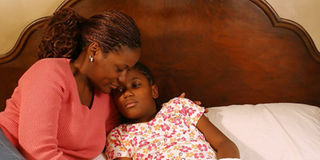Premium
Children at risk of urinary tract infections

A mother comforts her sick daughter. Two out of five people suffering from UTI are children, with even higher rates of female infections as compared to male. Photo/FILE
What you need to know:
- Young children, especially those of potty training age, are more likely to contract urinary tract infections. Here is how parents can prevent the painful and embarrassing affliction
She frequents the washroom more than usual. Emptying her bowel results in winces and whimpers. A red drop falls on the white toilet seat followed by a thin-reddish stream of foul-smelling urine in the toilet. These are all classic symptoms of a Urinary Tract Infection (UTI).
Two out of five people suffering from UTI are children, with even higher rates of female infections as compared to male. This is according to a study conducted in 2008 by the Aga Khan Hospital.
Urinary tract infection is a disease of the urinary tract of the human body caused by a bacterium, e.coli, which lives in the bowel part of the digestive system, where stool is changed from liquid to solid. Of the 409 urine samples drawn from patients with urine-related problems and studied, 109 belonged to children. The rest were of adult males and females.
Children who are infected tend to urinate quite frequently, experience pain when passing urine, and feel sharp pain in the back or side below the ribs. These have been singled out as the most common symptoms of urinary tract infection.
However, assessing symptoms in children is always a challenge, especially, infants and toddlers. Monitoring the frequency of urination is not enough. Use your eyes, and even nose to examine the nature of the urine. Cloudy, dark, bloody, or foul-smelling urine are also key indicators that the harmful bacteria is present in your child’s urinary tract.
This bug interferes with the cleansing of the body carried out in the kidneys, hence the symptoms. If not treated earlier, the bacteria encroach up the system and affect the bladder, kidneys and the ducts of the children infected. In extreme cases, deaths.
Children, mostly in diapers, potty training age and those still learning sanitary hygiene are more prone to infections of the urinary tract.
Mercy Anyango, a nurse at the Nyamira District Hospital paediatric wing, says: “Children who are left for long without a diaper change may get UTIs as a result of the transfer of the bacteria from the stool to the urethra. Similarly, children who are not taught how to wipe themselves properly after long calls suffer the most.”
Ideally, a child should wipe herself towards the back and not towards the front. Wiping forwards may result in the transfer of bacteria from the anus where they thrive. During the potty training age, children tend to be shy about peeing on themselves and often try to suppress the urge to urinate.”
Frequent urination helps keep the tract free from bacterial infection. For that reason, suppressing it makes the tract conducive for the bacteria settlement,” says Nurse Anyango.
In addition, those who do not take enough fluids pass less urine and this is not enough to flush out the bacteria from the tract.
Chronic constipation — where a child has less than two bowel movements in a week — is also risky. The stool in the body presses on the bladder, like squeezing part of a hose pipe to prevent water from going through, and hinders urination. This allows the bacteria to multiply in the tract.
Girls are more prone to UTI infections than boys and studies show that seven out of 10 people infected are women. This is attributed to women’s anatomical structure. A shorter urethra, its nearness to the rectum and the absence of a fluid (prostatic secretion), which acts as a steriliser in males, makes women more vulnerable.
However, uncircumcised boys were found to be more vulnerable as the foreskin provides a good environment for bacteria to thrive.
Dr N A Okinda, who headed the UTI research team, explained that children who are born with urinal tract abnormalities and those with suppressed immunity — reduced ability of the body to fight diseases — are an easy target of attacks by E. coli.
A urine test can show whether or not the bacteria is present. Nevertheless, Dr Okinda advises that patients who have shown signs of infection should be treated with antibiotics before the urine test is conducted.
“It is important to start the patient on anti-biotic treatment. However, caution should be taken while administering the same because E.Coli has shown resistance to a number of antibiotics.
“I would urge that patients take plenty of fluids, especially cranberry juice, but as supplements to conventional treatment.”
In general, women are more prone to unrinary tract infections, pregnant mothers being at greater risk due to the changes in the hormonal balance in the body that slightly suppresses the immune system. This hormonal balance disturbance also explains why women frequently experience UTIs just before their menses.
Then again, patients going through catheterisation treatment — insertion of a tube into their urethra up there bladder either for treatment or urine extractions, are an easy target of the infection especially those who are admitted in the hospital in situ compared to those who go for outpatient visits for the same
Other symptoms include:
Fever
Pain or burning during urination with only a few drops of urine at a time
Irritability
Loss of appetite
Nausea
Diarrhoea
Vomitting
Leaking urine into clothes or bedding in older children
Paediatric experts also advocate proper sanitary training in children in order to reduce the rate of infection. Remember if it doesn’t look and smell right, something is wrong.




